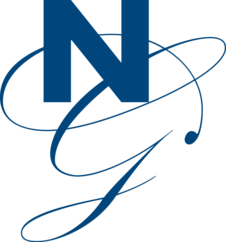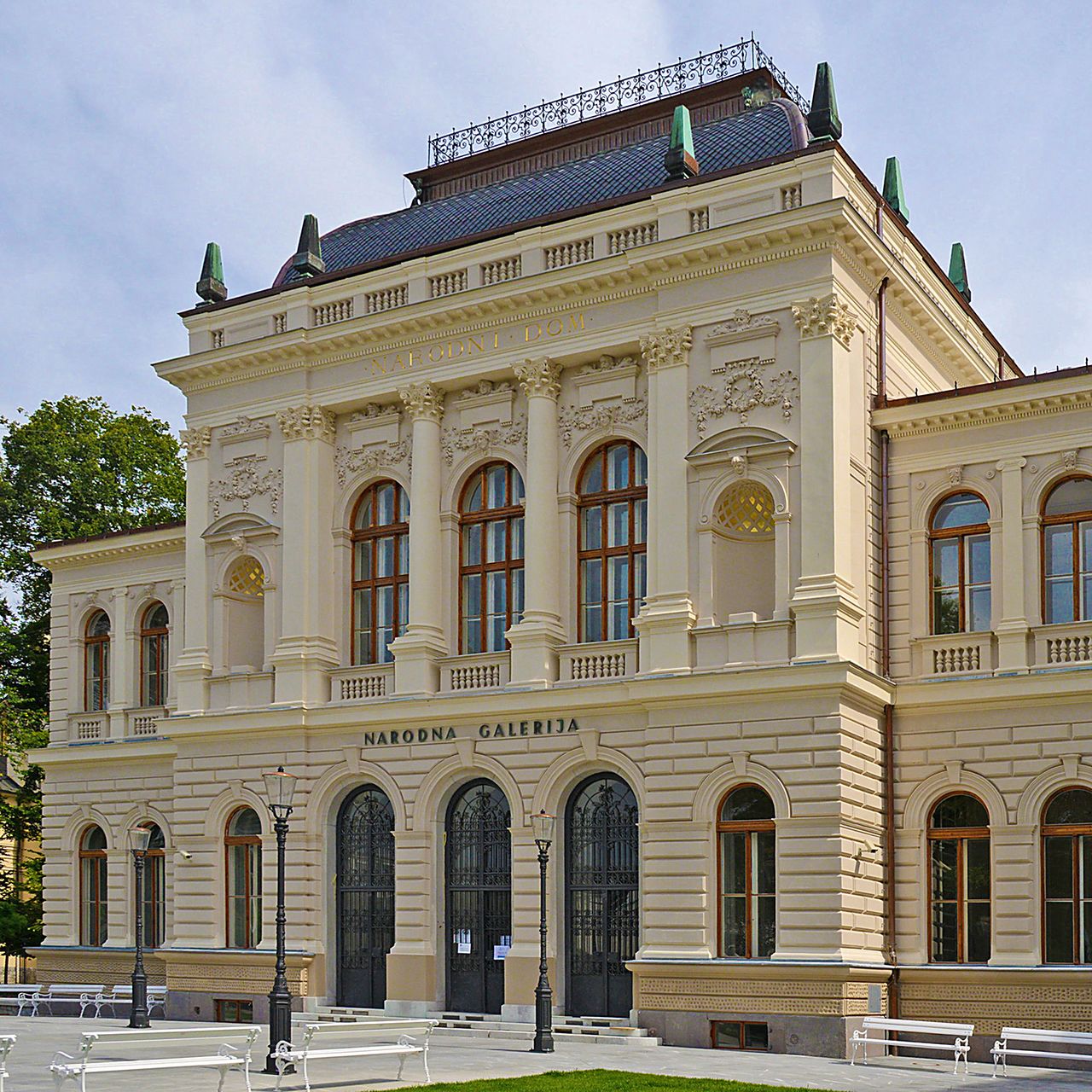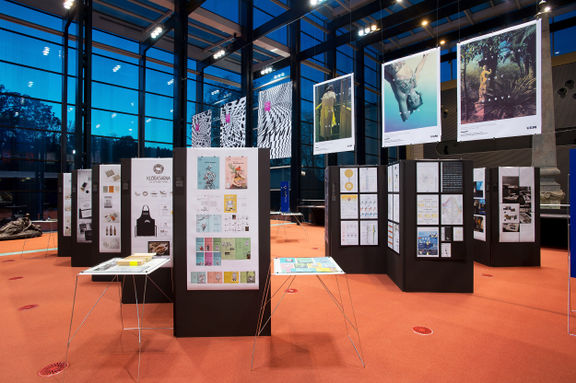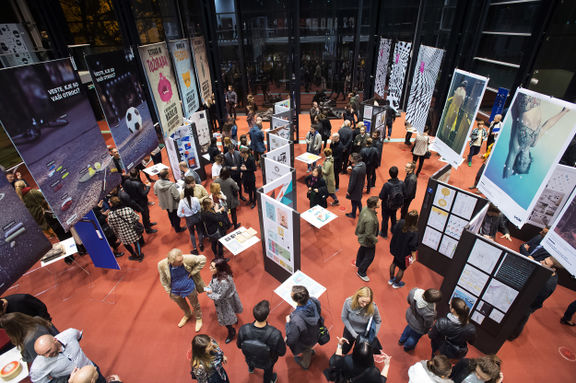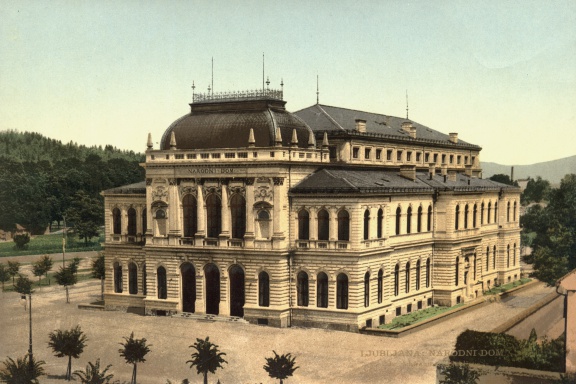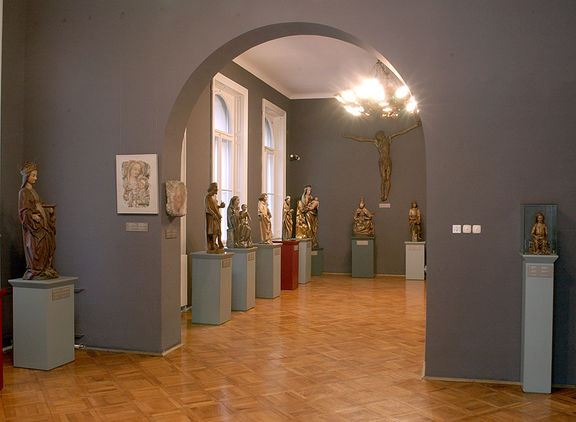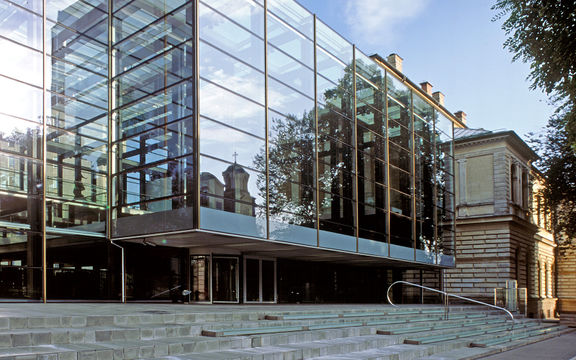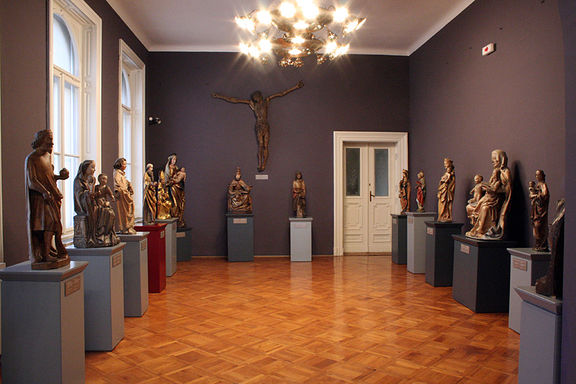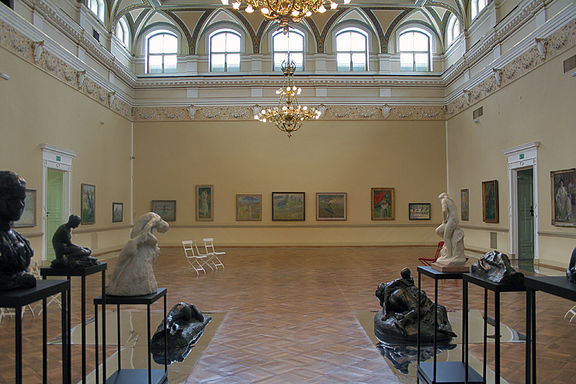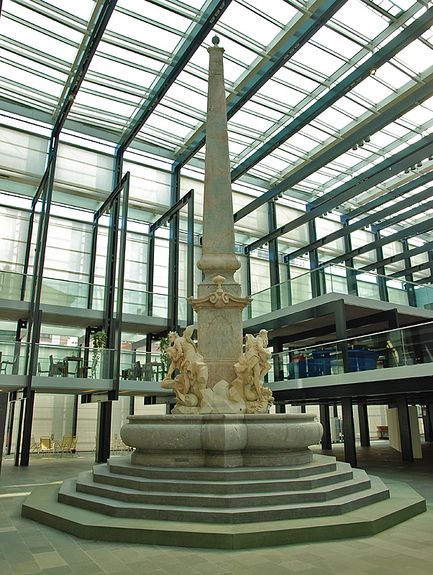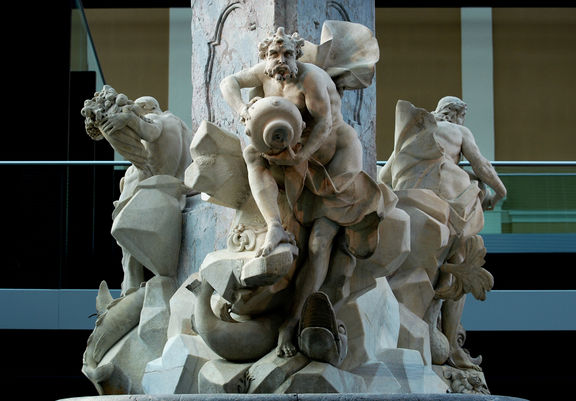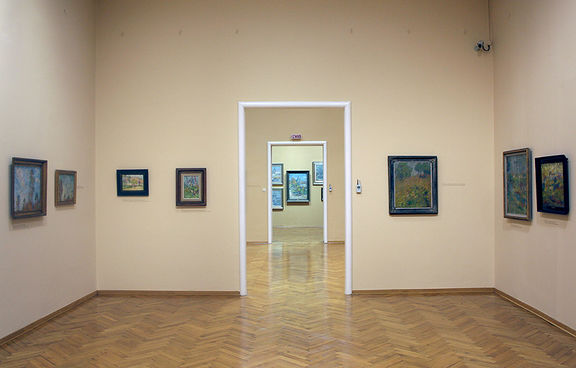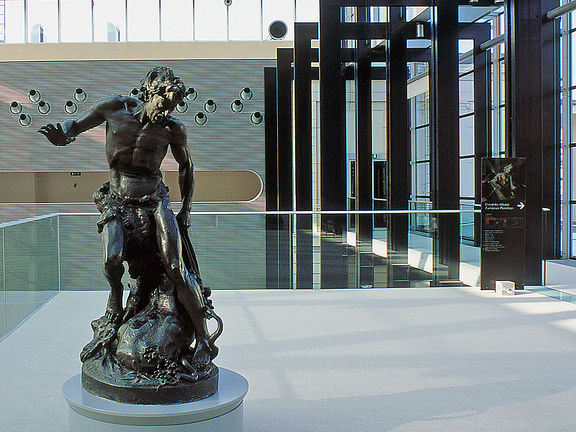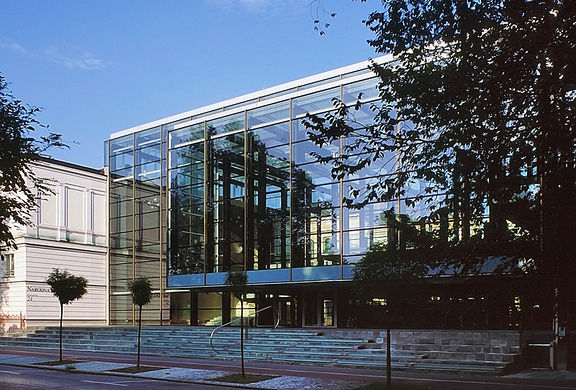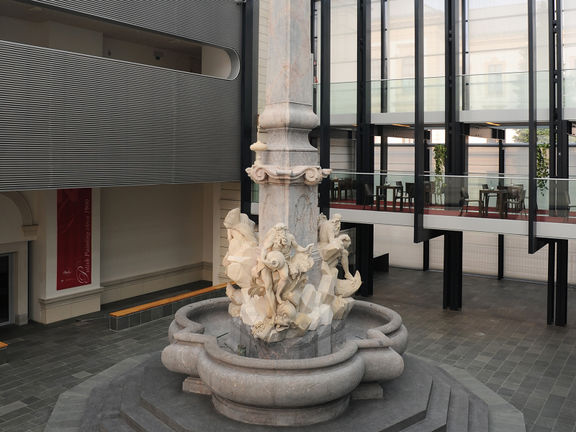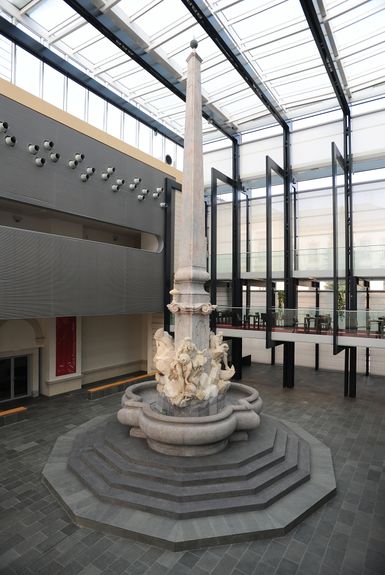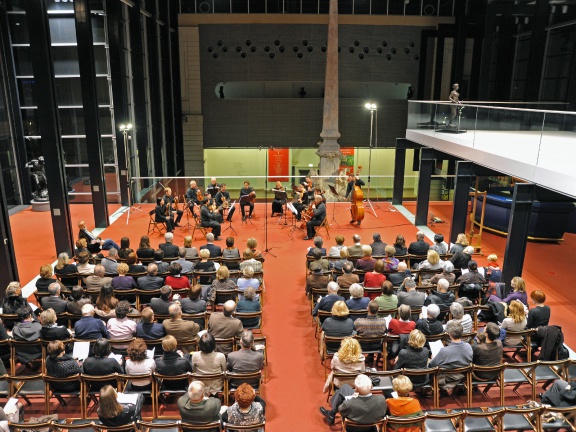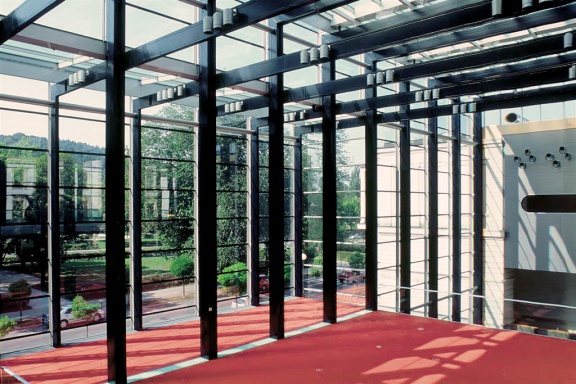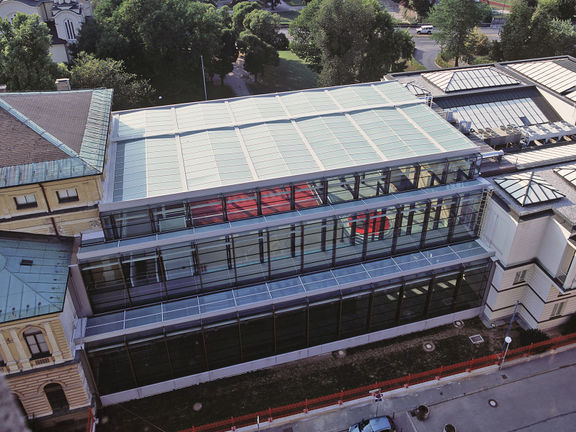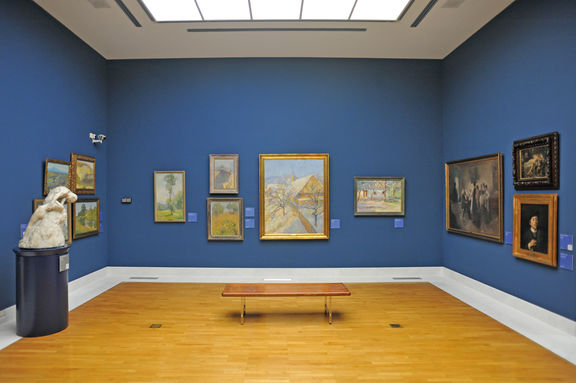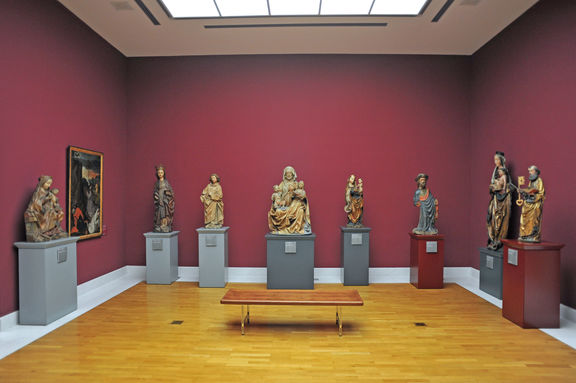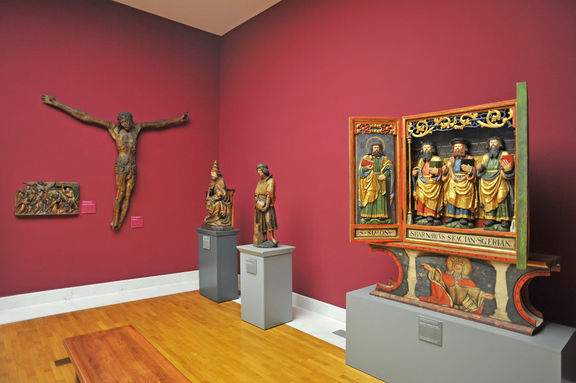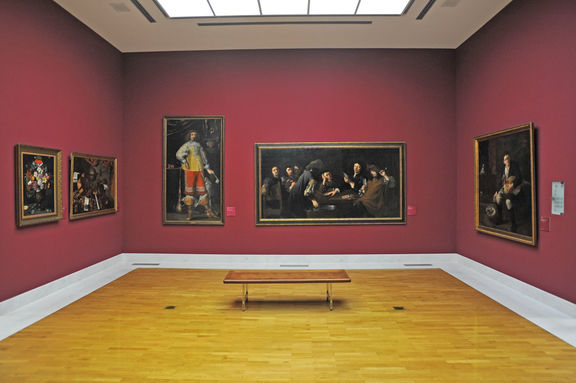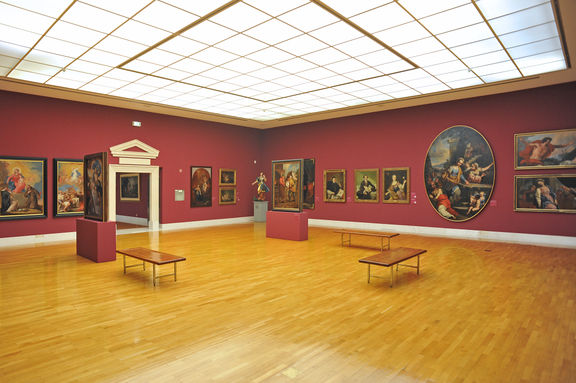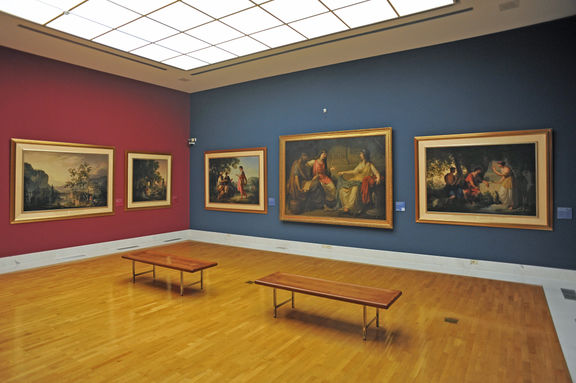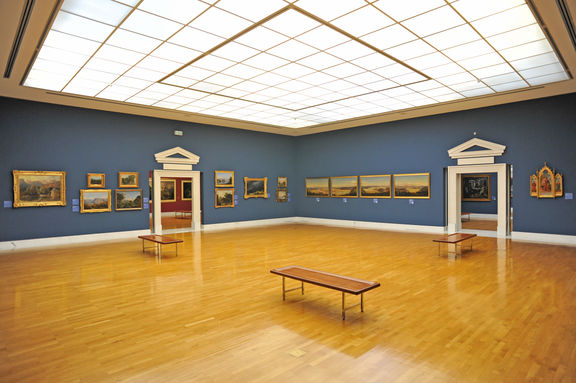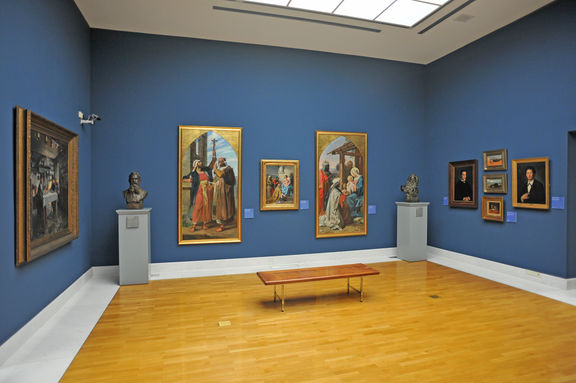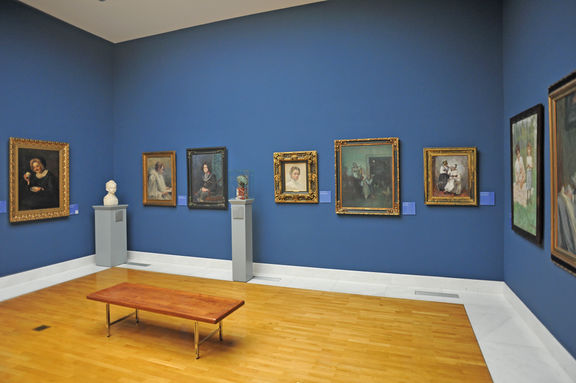Difference between revisions of "National Gallery of Slovenia"
(imported from XML by extractor/importer) |
(mwtool_article) |
||
| (138 intermediate revisions by 10 users not shown) | |||
| Line 1: | Line 1: | ||
{{Article | {{Article | ||
| − | | status = | + | | status = NEEDSUPDATE WRITING TOPROOFREAD NIFERTIK! |
| − | | maintainer = | + | | maintainer = Simon Žlahtič |
}} | }} | ||
| + | |||
{{Infobox | {{Infobox | ||
| name = National Gallery of Slovenia | | name = National Gallery of Slovenia | ||
| localname = Narodna galerija | | localname = Narodna galerija | ||
| − | | | + | | logo = National Gallery of Slovenia (logo).svg |
| town = SI-1000 Ljubljana | | town = SI-1000 Ljubljana | ||
| − | | | + | | street = Puharjeva 9 |
| − | | telephone = 386 (0) 1 241 | + | | telephone = 386 (0) 1 241 5418 (Gallery), 386 (0) 1 241 5400 (Management) |
| fax = 386 (0) 1 241 5403 | | fax = 386 (0) 1 241 5403 | ||
| email = info@ng-slo.si | | email = info@ng-slo.si | ||
| − | | website = | + | | website = https://www.ng-slo.si |
| − | | | + | | map = http://www.openstreetmap.org/?lon=14.50031&lat=46.05392&zoom=17&layer=mapnik |
| + | | founded by = Government of the Republic of Slovenia | ||
| + | | opening hours = 10am-6pm Tue-Sun | ||
| contacts = {{Contact | | contacts = {{Contact | ||
| − | | name = | + | | name = Barbara Jaki |
| role = Director | | role = Director | ||
| − | | email = | + | | email = |
| − | |||
| − | |||
| − | |||
| − | |||
}} | }} | ||
| + | | accounts = | ||
| + | https://twitter.com/narodnagalerija | ||
| + | https://www.facebook.com/ngslo | ||
| + | https://www.youtube.com/user/ngslo | ||
| + | https://www.instagram.com/narodnagalerija/ | ||
| + | |||
}} | }} | ||
| − | {{ | + | {{Teaser| |
| − | The [[National Gallery of Slovenia]] was founded | + | |
| + | {{Wide Image|National Gallery of Slovenia 2015 facade detail.jpg}} | ||
| + | |||
| + | The [[National Gallery of Slovenia]] (Narodna galerija) is the main art museum in Slovenia that holds the country's largest fine art collection from the late medieval period up to the early twentieth century. It was founded as early as [[Established::1918]] as the National Gallery Society with the aim of establishing a museum for Slovenian fine arts. First housed in the Kresija Palace, the Gallery relocated to the Narodni dom palace in 1926. | ||
| + | |||
| + | A completely reorganised and expanded permanent exhibition of the collections returned to public view in January 2016, following an extensive renovation of the Narodni dom palace. | ||
}} | }} | ||
| − | The National Gallery was originally housed in the Kresija | + | {{YouTube|okiXxbJKGr8}} |
| + | |||
| + | |||
| + | ==History== | ||
| + | |||
| + | |||
| + | {{Wide Image|National_Gallery_of_Slovenia_1910_postcard.jpg}} | ||
| + | |||
| + | The National Gallery of Slovenia was founded in 1918 as the National Gallery Society with the aim of establishing a museum for Slovenian fine arts. The National Gallery was originally housed in the Kresija Palace, where the first Permanent Exhibition was opened to the public in 1920. The Gallery relocated to the Narodni dom Palace in 1926, where it remains to this day. During the German occupation, the Gallery collections were relocated to the basements of the National Museum and the National and University Library. After the war, on 1 July 1946, the National Gallery of Slovenia became a state institution. | ||
| + | |||
| + | In the 1980s, the Gallery embarked on an expansion and renovation project that lasted for four decades. In 1988, the Gallery acquired the premises of the neighbouring Club of Delegates and in 1993 completed the New Wing in its lot. In 2001, the glass Entrance Hall, which connects the Narodni dom Palace and the New Wing, was completed. The Robba Fountain was placed inside the Entrance Hall in 2008. In 2009 the Gallery began the renovation of the Narodni dom Palace, which reopens in January 2016. | ||
| + | |||
| + | {{Wide Image|National Gallery of Slovenia - 2009 - 11.jpg}} | ||
| + | |||
| + | Next to permanent exhibition premises, there is an exhibition area for temporary exhibitions, educational activities and the [[National Gallery of Slovenia Library]]. | ||
| + | |||
| + | ==Collections== | ||
| + | |||
| + | After its foundation in 1918, the Gallery succeeded in a relatively short time in bringing together works from both public and private collections, including works by Slovenian artists purchased by the City of Ljubljana and works belonging to the Society for Christian Art; it also began to systematically purchase other works of art. An important acquisition was 90 paintings from the Strahl Collection. In 1927 the Gallery ordered casts of classical sculptures from the Louvre and in 1934 augmented its collection with fine art works belonging to the [[National Museum of Slovenia]]. After the [[Museum of Modern Art]] opened in 1947, many of the National Gallery's 20th-century works were transferred to the new museum. Throughout the Gallery’s history, numerous works of art were donated and bequeathed to the institution by artists themselves or their relatives, collectors, companies and individuals. | ||
| + | |||
| + | Today the Gallery's collection comprises 3,500 paintings, 1,000 pieces of sculpture, over 8,000 works on paper, and around 20,000 documents, thus taking care for the works of art by more than 1,000 artists. A selection of artworks is also accessible online. | ||
| + | |||
| + | The Permanent Collection of the National Gallery of Slovenia could be subdivided into Art in Slovenia, European Painters, Government Art Collection, Collection of Zoran A. Mušič (1909–2005), and a Special Collection. | ||
| + | |||
| + | A Collection of [[Zoran A. Mušič]] (1909–2005), a Slovene Modernist painter who established himself in the international art world (Venice and Paris), comprises 57 artworks that were donated to the gallery in 2014 by the artist’s niece, with further 40 works on loan. The Government Art Collection comprises over 1300 works of art that were acquired directly by the government, mostly after the Second World War, and kept in ministry and government buildings. The Gallery became the custodian of the collection in 1986. A Special Collection consists of a collection of posters, calendars and documents from the personal archives of Slovene artists who worked in the late 19th and in the first half of the 20th century. | ||
| + | |||
| + | |||
| + | {{Wide Image|National Gallery of Slovenia 2016 grand hall.jpg}} | ||
| + | |||
| + | |||
| + | == Permanent exhibition set anew== | ||
| + | |||
| + | As the premises were expanded, in January 2016 a permanent exhibition was reinstalled: it features a new selection of works from all the collections arranged chronologically, covering the period between the 13th and the early 20th century. | ||
| + | |||
| + | ==Temporary exhibitions programme== | ||
| + | |||
| + | The museum's programme counts approximately 4 major and 15 small-scale exhibitions per year. The majority of them are prepared by the house curators, some are acquired by exchange with international institutions or prepared by other Slovene organisations (e.g. [[Biennial of Slovene Visual Communications]]). | ||
| − | |||
| − | + | == International Cooperation == | |
| − | + | On 17 April 2013 the exhibition ''Slovenian Impressionists and their time (1890–1920)'', curated by Sylvain Lecombre and [[Barbara Jaki]], opened at the Petit Palais Museum in Paris. To date, it was the largest exhibition of Slovenian art in Western Europe. | |
| − | The National Gallery of Slovenia also | + | The Gallery works together with many European art museums and institutions, including Uffizi Gallery, Italy; National Sculpture Museum of Spain, Spain; National Museum in Warsaw, Poland; University of Galway, Ireland; Regional Council of Lower Normandy, France; Finnish National Gallery, Finland; and Gallery of Matica srpska, Serbia. |
| + | |||
| + | {{Wide Image|Petit Palais 2013 Slovene Impressionism and their Time 1890–1920 exhibition 09.jpg}} | ||
| + | |||
| + | ==The Robba Fountain== | ||
| + | |||
| + | [[Francesco Robba]] (1698–1757), whose oeuvre connected Ljubljana with contemporary Venetian art, created the fountain between 1743 and 1751, and modelled it on the famous Roman fountains. The sculptures of the three river gods decorating it most probably represent three rivers in the then province of Carniola, namely the Sava, the Ljubljanica and the Krka. The original fountain was removed from Ljubljana's Mestni trg Square and replaced by a copy. The original, refurbished and restored, now resides in the Entrance Hall of the National Gallery of Slovenia. | ||
| + | |||
| + | {{Wide Image|National Gallery of Slovenia - 2008 - 08.jpg}} | ||
| + | |||
| + | ==Music programme == | ||
| + | |||
| + | Since 2001 the National Gallery hosts each year a cycle of concerts by the [[Slovene Philharmonic String Chamber Orchestra]], entitled ''Harmony of the Spheres'' [Sozvočja svetov]. The events combine lectures on fine arts with concerts of chamber music, which include pieces from the classical repertoire and original compositions. | ||
| + | |||
| + | == Education Department== | ||
| + | |||
| + | The Education Department of the Gallery was founded in 1961 and is among the oldest in the country. Children’s programming encourages art exploration through the adventures of Gal the Dwarf, the mascot of the Gallery since 1981, setting up the Motivational Gallery exploration space, called Gal’s Room, in the gallery. Education Department each year organizes around 200 public events and welcomes more than 20,000 young visitors. | ||
| + | |||
| + | ==Artworks loan, venue hire== | ||
| + | |||
| + | The National Gallery also loans its artworks and photo material for exhibitions and publications, according to international standards. It is also possible to hire the gallery spaces for events. | ||
== See also == | == See also == | ||
* [[National Gallery of Slovenia Library]] | * [[National Gallery of Slovenia Library]] | ||
| + | * [[Museum of Modern Art]] | ||
| + | * [[:Category:Slovene Impressionists and their Time|Slovene Impressionists and their Time]] | ||
| + | |||
| + | ==External links== | ||
| + | * [https://www.ng-slo.si/en/ National Gallery of Slovenia website] | ||
| + | * [http://www.ng-slo.si/en/permanent-collection National Gallery of Slovenia Permanent Collection overview] | ||
| + | * [http://www.ng-slo.si/en/about-the-national-gallery-of-slovenia National Gallery history] | ||
| + | * [http://en.wikipedia.org/wiki/National_Gallery_of_Slovenia National Gallery of Slovenia on Wikipedia] | ||
| + | * [http://www.artnouveau-net.eu/ Réseau Art Nouveau Network website] | ||
| + | Projects | ||
| + | * [https://itunes.apple.com/us/book/slovene-impressionists-their/id548242521?mt=11 ''Slovene Impressionists and their time'' catalogue, free for iOS devices] (in English) | ||
| + | * [https://www.academia.edu/6562306/Ivana_Kobilca_and_Her_Painting_for_the_Ljubljana_Town_Hall_Slovenia_Bows_to_Ljubljana_in_the_Context_of_Womens_Painting_in_the_Late_Nineteenth_Century Article on Academia.edu by Beti Žerovc about Ivana Kobilca] | ||
| + | |||
| + | {{gallery}} | ||
| + | |||
| + | |||
| + | [[Category:Museums]] | ||
| + | [[Category:Visual arts galleries]] | ||
| + | [[Category:Visual arts museums]] | ||
| + | [[Category:Visual arts]] | ||
| + | |||
| + | [[Category:Galleries]] | ||
| + | |||
| + | [[Category:Visual arts research]] | ||
| + | [[Category:Research]] | ||
| + | |||
| + | [[Category:Architecture exhibition venues]] | ||
| + | [[Category:Venues]] | ||
| + | [[Category:National museums]] | ||
| + | [[Category:Venues]] | ||
| + | [[Category: National cultural institutions]] | ||
| − | [[Category: | + | [[Category:Slovene Impressionists and their Time]] |
| + | [[Category:Education_and_Research]] | ||
Latest revision as of 01:45, 19 February 2021
-
to
2 Dec 2020
31 Jan 2021
Alan Ford’s Lap of Honour, a guest comics exhibition by the National Gallery of Slovenia and the Institute of Culture and Education and Glavan Antiquariat in Ljubljana, hosted by the Museum of Yugoslavia in cooperation with the Italian Institute of Culture in Belgrade and the Yugoslav Film Archive, promoted by the Embassy of the Republic of Slovenia Belgrade
-
to
17 May 2019
16 Sep 2019
Impressionism from Dawn till Dusk. Slovenian Art 1870–1930, a large-scale exhibition organised by the National Gallery of Slovenia
-
to
5 Dec 2018
14 Jan 2019
Šubic in the Land of Classical Greece exhibition presenting mural paintings in the Schliemman's house in Athens by Jurij Šupic (1855-1890), in collaboration with the National Gallery of Slovenia and the Embassy of the Republic of Slovenia Athens,
-
to
13 Apr 2018
6 Aug 2018
Poetry of Silence, an exhibition of works by Zoran Mušič, featuring loans from Moderna galerija / Museum of Modern Art, Ljubljana plus Museum of Contemporary Art Metelkova and National Gallery of Slovenia, supported by the Slovenian Culture and Information Centre, Vienna (SKICA) (Embassy of the Republic of Slovenia Vienna),
-
26 Jan 2018
A symposium on Zoran Mušič's opus, with Andrej Smrekar (National Gallery of Slovenia) Zdenka Badovinac and Marko Jenko (Moderna galerija / Museum of Modern Art, Ljubljana plus Museum of Contemporary Art Metelkova participating,
-
to
21 Oct 2016
12 Feb 2017
Is that Biedermeier?, a painting exhibition featuring several works by Slovenian artists, courtesy of the National Gallery of Slovenia,
-
to
12 Jul 2014
12 Oct 2014
An exhibition of crucifixes and wooden sculptures from the time of the Patriarch of Aquilea Pellegrino II also featuring four crucifixes from Slovenia, one from the National Gallery of Slovenia,
-
to
18 Jan 2014
20 Apr 2014
The exhibition 1914, organised in the framework of Riga - the European Capital of Culture, featuring works by France Kralj and Tone Kralj (Božidar Jakac Gallery), Fran Tratnik (National Museum of Contemporary History), and Ivan Vavpotič (National Gallery of Slovenia)
-
to
18 Apr 2013
13 Jul 2013
Slovene Impressionists and their time 1890–1920 exhibition organised by the Petit Palais and the National Gallery of Slovenia in cooperation with the Embassy of the Republic of Slovenia Paris
History
 Narodni dom (National House) building by František Škabrout, built in Ljubljana 1894–1896. In 1927 the National Gallery of Slovenia rented some rooms in the building that housed also sport and leisure activities. Postcard, 1910.
Narodni dom (National House) building by František Škabrout, built in Ljubljana 1894–1896. In 1927 the National Gallery of Slovenia rented some rooms in the building that housed also sport and leisure activities. Postcard, 1910.
The National Gallery of Slovenia was founded in 1918 as the National Gallery Society with the aim of establishing a museum for Slovenian fine arts. The National Gallery was originally housed in the Kresija Palace, where the first Permanent Exhibition was opened to the public in 1920. The Gallery relocated to the Narodni dom Palace in 1926, where it remains to this day. During the German occupation, the Gallery collections were relocated to the basements of the National Museum and the National and University Library. After the war, on 1 July 1946, the National Gallery of Slovenia became a state institution.
In the 1980s, the Gallery embarked on an expansion and renovation project that lasted for four decades. In 1988, the Gallery acquired the premises of the neighbouring Club of Delegates and in 1993 completed the New Wing in its lot. In 2001, the glass Entrance Hall, which connects the Narodni dom Palace and the New Wing, was completed. The Robba Fountain was placed inside the Entrance Hall in 2008. In 2009 the Gallery began the renovation of the Narodni dom Palace, which reopens in January 2016.
 National Gallery of Slovenia, view of the northern wing by Edvard Ravnikar and the entrance hall by SADAR + VUGA Architects, 2009.
National Gallery of Slovenia, view of the northern wing by Edvard Ravnikar and the entrance hall by SADAR + VUGA Architects, 2009.
Next to permanent exhibition premises, there is an exhibition area for temporary exhibitions, educational activities and the National Gallery of Slovenia Library.
Collections
After its foundation in 1918, the Gallery succeeded in a relatively short time in bringing together works from both public and private collections, including works by Slovenian artists purchased by the City of Ljubljana and works belonging to the Society for Christian Art; it also began to systematically purchase other works of art. An important acquisition was 90 paintings from the Strahl Collection. In 1927 the Gallery ordered casts of classical sculptures from the Louvre and in 1934 augmented its collection with fine art works belonging to the National Museum of Slovenia. After the Museum of Modern Art opened in 1947, many of the National Gallery's 20th-century works were transferred to the new museum. Throughout the Gallery’s history, numerous works of art were donated and bequeathed to the institution by artists themselves or their relatives, collectors, companies and individuals.
Today the Gallery's collection comprises 3,500 paintings, 1,000 pieces of sculpture, over 8,000 works on paper, and around 20,000 documents, thus taking care for the works of art by more than 1,000 artists. A selection of artworks is also accessible online.
The Permanent Collection of the National Gallery of Slovenia could be subdivided into Art in Slovenia, European Painters, Government Art Collection, Collection of Zoran A. Mušič (1909–2005), and a Special Collection.
A Collection of Zoran A. Mušič (1909–2005), a Slovene Modernist painter who established himself in the international art world (Venice and Paris), comprises 57 artworks that were donated to the gallery in 2014 by the artist’s niece, with further 40 works on loan. The Government Art Collection comprises over 1300 works of art that were acquired directly by the government, mostly after the Second World War, and kept in ministry and government buildings. The Gallery became the custodian of the collection in 1986. A Special Collection consists of a collection of posters, calendars and documents from the personal archives of Slovene artists who worked in the late 19th and in the first half of the 20th century.
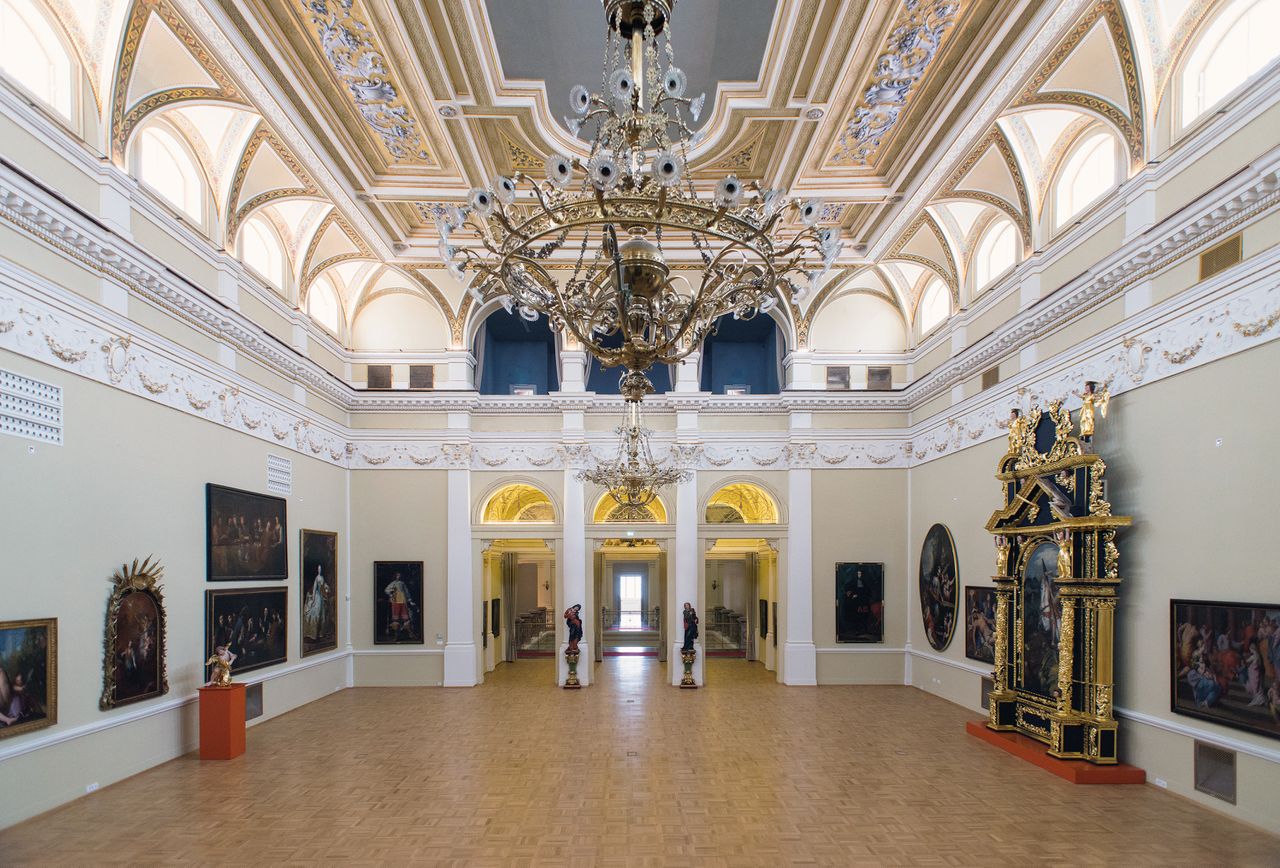 The 2016 set up of the permanent collection of the National Gallery of Slovenia in the grand hall.
The 2016 set up of the permanent collection of the National Gallery of Slovenia in the grand hall.
Permanent exhibition set anew
As the premises were expanded, in January 2016 a permanent exhibition was reinstalled: it features a new selection of works from all the collections arranged chronologically, covering the period between the 13th and the early 20th century.
Temporary exhibitions programme
The museum's programme counts approximately 4 major and 15 small-scale exhibitions per year. The majority of them are prepared by the house curators, some are acquired by exchange with international institutions or prepared by other Slovene organisations (e.g. Biennial of Slovene Visual Communications).
International Cooperation
On 17 April 2013 the exhibition Slovenian Impressionists and their time (1890–1920), curated by Sylvain Lecombre and Barbara Jaki, opened at the Petit Palais Museum in Paris. To date, it was the largest exhibition of Slovenian art in Western Europe.
The Gallery works together with many European art museums and institutions, including Uffizi Gallery, Italy; National Sculpture Museum of Spain, Spain; National Museum in Warsaw, Poland; University of Galway, Ireland; Regional Council of Lower Normandy, France; Finnish National Gallery, Finland; and Gallery of Matica srpska, Serbia.
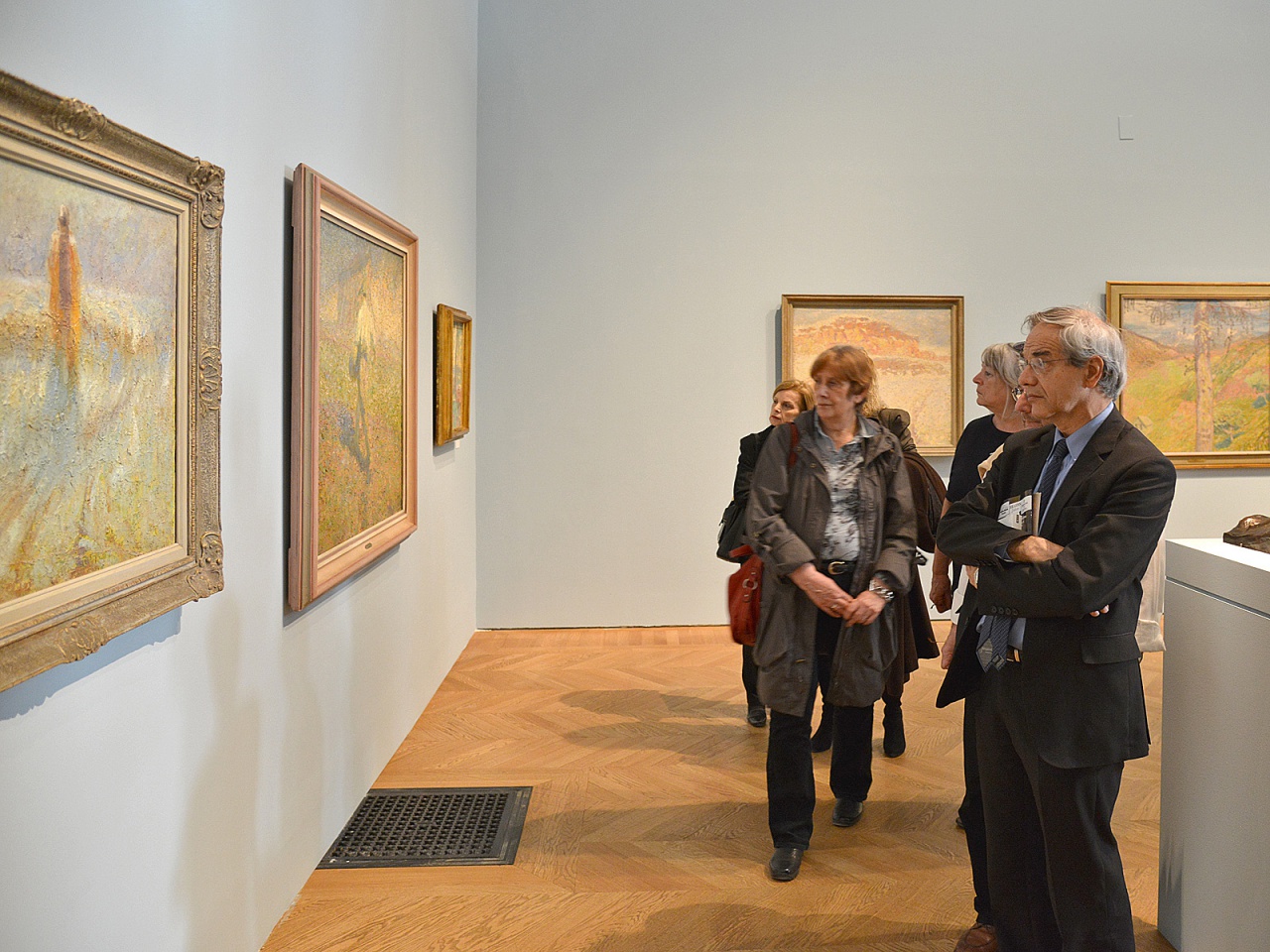 Slovene Impressionism and their Time 1890–1920 exhibition at Petit Palais, Paris , 2013
Slovene Impressionism and their Time 1890–1920 exhibition at Petit Palais, Paris , 2013
The Robba Fountain
Francesco Robba (1698–1757), whose oeuvre connected Ljubljana with contemporary Venetian art, created the fountain between 1743 and 1751, and modelled it on the famous Roman fountains. The sculptures of the three river gods decorating it most probably represent three rivers in the then province of Carniola, namely the Sava, the Ljubljanica and the Krka. The original fountain was removed from Ljubljana's Mestni trg Square and replaced by a copy. The original, refurbished and restored, now resides in the Entrance Hall of the National Gallery of Slovenia.
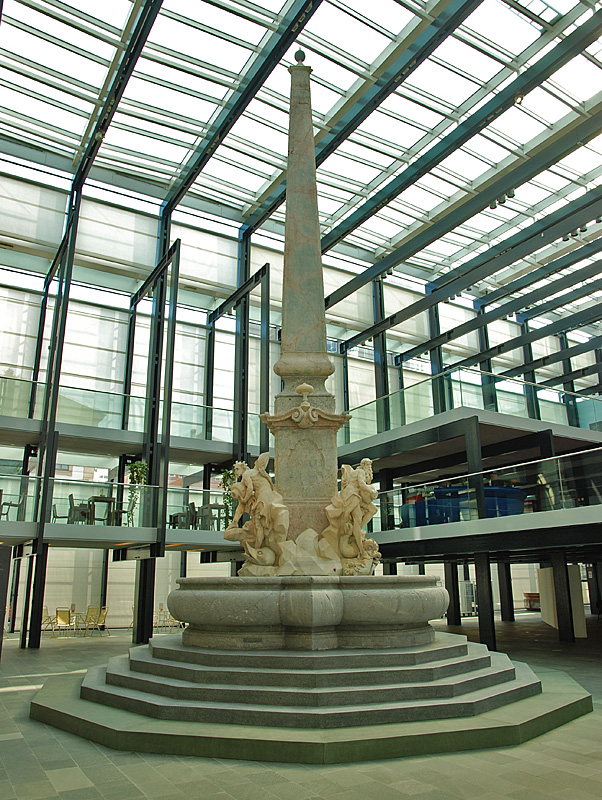 The restored Robba Fountain by Baroque sculptor Francesco Robba was installed in the National Gallery of Slovenia entrance hall in 2006.
The restored Robba Fountain by Baroque sculptor Francesco Robba was installed in the National Gallery of Slovenia entrance hall in 2006.
Music programme
Since 2001 the National Gallery hosts each year a cycle of concerts by the Slovene Philharmonic String Chamber Orchestra, entitled Harmony of the Spheres [Sozvočja svetov]. The events combine lectures on fine arts with concerts of chamber music, which include pieces from the classical repertoire and original compositions.
Education Department
The Education Department of the Gallery was founded in 1961 and is among the oldest in the country. Children’s programming encourages art exploration through the adventures of Gal the Dwarf, the mascot of the Gallery since 1981, setting up the Motivational Gallery exploration space, called Gal’s Room, in the gallery. Education Department each year organizes around 200 public events and welcomes more than 20,000 young visitors.
Artworks loan, venue hire
The National Gallery also loans its artworks and photo material for exhibitions and publications, according to international standards. It is also possible to hire the gallery spaces for events.
See also
External links
- National Gallery of Slovenia website
- National Gallery of Slovenia Permanent Collection overview
- National Gallery history
- National Gallery of Slovenia on Wikipedia
- Réseau Art Nouveau Network website
Projects
- Slovene Impressionists and their time catalogue, free for iOS devices (in English)
- Article on Academia.edu by Beti Žerovc about Ivana Kobilca



